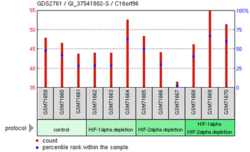Biology:C16orf96
 Generic protein structure example |
C16orf96, or chromosome 16 open reading frame 96, is a protein in humans that is encoded by C16orf96 that is found on the 16th chromosome.[1] In Homo sapiens, the protein is 1141 amino acids in length[2]
Protein
Characteristics
The molecular weight of the processed C16orf96 protein in humans is 125kdal with an isoelectric point of 6.58[3] About 9% of the amino acid makeup of C16orf96 is proline, which is significantly higher than an average human gene.[4]
Post Translational Modification
Human C16orf96 has a large amount of predicted phosphorylation sites on serines throughout the protein.[5] C16orf96 also has been found in primates and mammals to have both a nuclear import and export signal[6]
Domains
This gene contains some known domains, such as: an RNA recognition motif, a Merozoite surface protein (MSP-1), a pentapeptide repeat MXKDX, and a domain of unknown function (DUF1387). These domains could give a hint of what the function of this gene is.[2]
Structure
Secondary Structure
The majority of the secondary structure of C16orf96 is alpa-helices with coils being the second most abundant structure.[7]
Tertiary Structure
At this time there is no known tertiary structure for C16orf96.
Cellular Localization
The C16orf96 protein is predicted to be localized in the nucleus 82% of the time and 4.5% of the time in the cytosol and 4.5% of the time in the mitochondria.[8]
Expression

C16orf96 expression is generally low in cells. in situ hybridization experiments suggest that C16orf96 RNA is only expressed in the testis while the EST profile for C16orf96 shows gene expression is low in testis and skin only.[9][10] Expression of the C16orf96 gene is modulated by the depletion of both hypoxia induced factor 1/2α (HIF1/2α). When only one of the factors is depleted expression does not change suggesting that there is redundancy with these two HIF.[11]
Homology
Strict orthologs of this gene exist only in mammals. However, a portion of DUF1387 is found in more distant species back to reptiles.[12] No orthologs of this gene can be found in plants, fungi, or bacteria. Suggesting that this gene is relatively new and evolves quickly.
Function
The function of C16orf96 is currently unknown. Studies have cited this gene among many other genes as a possible candidate that has an effect on childhood obesity.[13]
References
- ↑ "The sequence and analysis of duplication-rich human chromosome 16". Nature 432 (7020): 988–94. December 2004. doi:10.1038/nature03187. PMID 15616553. Bibcode: 2004Natur.432..988M.
- ↑ 2.0 2.1 NCBI Protein NP_001138483
- ↑ GeneCards C16orf96
- ↑ Biology Workbench: SAPS Tool[yes|permanent dead link|dead link}}]
- ↑ NetPhos 2.0
- ↑ NetNES 1.1
- ↑ Biology Workbench: PELE Tool
- ↑ "PSORT II Server". http://www.genscript.com/cgi-bin/tools/psort2.pl.
- ↑ The Human Protein Atlas of C16orf96
- ↑ EST profile Hs.684212
- ↑ GeoProfiles ID:40057343
- ↑ NCBI BLAST
- ↑ "Novel genetic loci identified for the pathophysiology of childhood obesity in the Hispanic population". PLOS ONE 7 (12): e51954. 2012. doi:10.1371/journal.pone.0051954. PMID 23251661.]
External links
- Human C16orf96 genome location and C16orf96 gene details page in the UCSC Genome Browser.
 |


